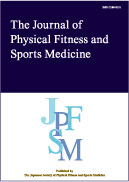
- Issue 6 Pages 147-
- Issue 5 Pages 119-
- Issue 4 Pages 95-
- Issue 3 Pages 69-
- Issue 2 Pages 35-
- Issue 1 Pages 1-
- |<
- <
- 1
- >
- >|
-
Hiroaki Kijima, Masashi Fujii, Tetsuya Kawano, Hidetomo Saito, Nao ...Article type: Regular Article
2023Volume 12Issue 2 Pages 35-44
Published: March 25, 2023
Released on J-STAGE: March 13, 2023
JOURNAL OPEN ACCESSMedical checkups for adolescent athletes aim to prevent or detect sports injuries and manage them before they hamper future sports activities and daily life. However, effective items for evaluation, as well as the areas of intervention to prevent sports injuries, remain unclear. We aimed to clarify the checkup items and intervention areas to prevent sports injuries in adolescent athletes. This is a cross-sectional observational study that investigated the presence or absence of pain in adolescent athletes and associated factors at the time of checkup. We investigated joint laxity, range of motion (ROM), finger-floor distance (FFD), heel–buttock distance (HBD), straight leg raising (SLR) angle, too many toes sign, and presence or absence of low back pain during lumbar extension in 301 junior high school athletes. Additionally, after confirming the developmental stage of the tibial tuberosity using ultrasonography, ultrasound elastography was used to quantify the elasticity of the quadriceps femoris, and items related to pain during sports activities were extracted. Items related to pain included the too many toes sign, low back pain during lumbar extension, and elasticity of the quadriceps femoris. Athletes with a positive too many toes sign were less likely to experience pain; conversely, the harder the quadriceps femoris, the more likely they were to experience pain. Medical checkups focusing on these items are effective for adolescent athletes who are prone to knee pain.
View full abstractDownload PDF (1232K) -
Fumi Hasebe, Maiko Miura, Kasumi Ono, Yuta Goto, Hiroki Nakata, C ...Article type: Regular Article
2023Volume 12Issue 2 Pages 45-57
Published: March 25, 2023
Released on J-STAGE: March 13, 2023
JOURNAL OPEN ACCESSIn this study, we investigated the differences in performance and kinematics between overground and treadmill running using the same amount of subjective effort. Fourteen female participants performed a 50-m sprint, running at maximum effort (100% subjective effort) as the maximal task on the ground. Subsequently, based on 100% subjective effort, they performed the grading task on the ground and on the treadmill at 30, 50, and 70% subjective effort. The running motion was recorded using a high-speed camera. We observed a significant difference in running velocity between the overground and treadmill conditions because treadmill running was recognized as having a greater load than overground running. The running velocity could be adjusted according to the subjective effort required for both overground and treadmill running. On the treadmill, running velocity was adjusted by maintaining flight time with increased subjective effort. Additionally, running velocity was adjusted by both step frequency and step length on the treadmill, whereas overground running velocity was adjusted by step frequency rather than step length. We also observed that overground, the knee angle was more flexible with an increase in subjective effort through one gait cycle, and the ankle joint was fixed at a high subjective effort. On the treadmill, the knee angle was adjusted only during the swing phase, and greater dorsiflexion was observed at high subjective effort.
View full abstractDownload PDF (964K) -
Tatsuya Hashitomi, Daisuke Hoshi, Takashi Tarumi, Jun Sugawara, Koi ...Article type: Regular Article
2023Volume 12Issue 2 Pages 59-67
Published: March 25, 2023
Released on J-STAGE: March 13, 2023
JOURNAL OPEN ACCESS
Supplementary materialPrevious studies have shown that normal and complex land walking (e.g. dual-task and obstacle walk) have a positive effect on the prefrontal cortex (PFC) and executive function. However, little is known about the benefits of aquatic walking. The underwater environment is a complex environment with water flow and resistance. Such an environment may induce different brain responses than the land environment. These responses can possibly affect brain function. Therefore, we hypothesized that aquatic walking enhances PFC and executive function more than land walking. Seven participants (age: 57.6 ± 7.0 years, body mass index: 22.9 ± 4.6 kg m−2) performed walking for 10 mins at a self-selected comfortable speed in both conditions. Then, the color-word Stroop task (CWST) was administered at pre- and post-exercises. The left prefrontal hemoglobin activity was monitored via functional near-infrared spectroscopy during the CWST and walking trial. Stroop interference performance, which reflects executive function, was calculated using reaction time and hemoglobin activity during the CWST. Compared to land walking, aquatic walking enhanced cortical activations and reaction time in the Stroop interference. In addition, aquatic walking was more likely to enhance cortical function than land walking. Hence, aquatic walking can induce higher cortical activation relative to land walking at a similar intensity, and it promotes executive function in healthy middle- and old-aged individuals.
View full abstractDownload PDF (1247K)
- |<
- <
- 1
- >
- >|